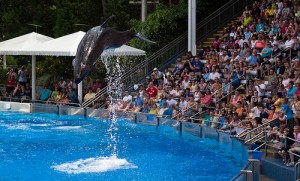6. Economics
Economics
Keeping of dolphins in public aquariums is definitely a draw for the public. These animals are charismatic and ever since the popularization of dolphins with 1963’s “Flipper,” people have been interested in getting a closer view of dolphins. There are two sides of the coin to consider when talking about the economics of keeping dolphins. The first side involves the costs, and the second involves the profits.
Costs
There are significant costs involved with building and maintaining dolphin pools. Dolphin habitats are often the largest or one of the largest sized pools in a marine park or aquarium, along with pools for other large marine mammals such as belugas and orcas. Paying the staff (trainers, veterinarians, maintenance workers, etc) that are required to keep the dolphins in good health and the exhibit in working order is another component to the operating costs of a dolphin exhibit. Of course food, medicines, veterinary treatments, and toys/enrichment are also things to consider. There are also significant costs involved in acquiring animals, from the wild or from other facilities. Transporting a large marine mammal is a delicate process that involves a lot of specialized equipment as well as constant monitoring of the animals during transport. Then there is the cost of the animal itself. Often animals are transferred between facilities as part of an exchange for breeding purposes, but purchasing of animals also happens. The two dolphins that reside at the Vancouver Aquarium were purchased in 2005 from the Enoshima Aquarium in Japan.
There are numerous welfare issues that can arise from the costs involved in acquiring and keeping dolphins. Facilities with insufficient budgets may not make enough of an investment when constructing and maintaining the facilities the dolphins are kept in, resulting in pools with inappropriate size, filtration, acoustic properties or other problems. While the major facilities in Canada and the US follow care and maintenance guidelines for accreditation programs such as the Canadian Association of Zoos and Aquariums (CAZA) and the American Association of Zoos and Aquariums (AZA), facilities in other countries may not follow such guidelines. Outside of North America and Europe, there are few guidelines or regulations regarding captive animals and no international oversight mechanisms (Rose et al. 2009). Facilities in poorer countries may lack the finances and expertise to care for marine mammals. The acquisition of dolphins can also have significant welfare issues. Drive hunting in Japan is a well-known animal welfare issue. Dolphins are rounded up and driven into shallow bays where they are slaughtered en masse for the sale of their meat, causing stress, panic, and suffering through inhumane slaughter (WDCS 2006). Increasingly, there has been a secondary reason for these drive hunts besides the sale of dolphin carcasses, and this is the sale of live dolphins to aquariums (WDCS 2006). The reported sale price for a dolphin carcass is between $300-400 USD, while the sale of a live dolphin fetches from $3000-$5000 USD (WDCS 2006). The higher prices that some aquaria are paying for live dolphins caught by these hunts provide more of a financial incentive for them to continue, which causes more suffering (WDCS 2006). Meanwhile, the aquariums that purchase from these hunts get dolphins cheaper than if they were to acquire them through more reputable sources, with a fully trained aquarium bottlenose dolphin costing up to $100,000 (WDCS 2006).
Profits
Given the costs of acquiring and maintaining marine mammals, there must be a strong incentive for facilities to take on these costs in order to display these animals. The primary reason facilities display dolphins and other marine mammals is because it is profitable to do so. As observed by the 1999 Lien Report, people vote with their feet when it comes to the display of dolphins in aquariums (Lien 1999). Based on a survey done by the Vancouver Aquarium, visitations would decrease by an estimated 28% if the aquarium did not hold cetaceans (Lien 1999). Looking at 3 of the major animal oriented attractions across Canada also indicates the importance of cetaceans to drawing customers. Marineland in Ontario is privately owned and profitable, the Vancouver Aquarium is a not for profit institution that is self sustaining for its normal operating budget, and the Montreal Biodome requires yearly government contributions to stay in business (Lien 1999). Of the three, it is only the Biodome that does not keep whales or dolphins. Dolphins in marine parks are used for daily acrobatic shows, and in many locations there are opportunities to interact with the dolphins more closely, in a personal training session, swim with the dolphins or dolphin petting pool, for an additional charge.
